|
The
Maori language (Te Reo) belongs to the Polynesian sub-family of languages, a fact
which enabled Captain Cook's Tahitian interpreter, Tupaia, to translate for him
on his initial voyage of discovery to New Zealand in 1769. As far
distant as Hawai'i, changing the Maori k to the glottal stop represented
by ' in written Hawai'ian, and the Maori r with l makes many words
comprehensible. The roots of the polynesian languages, like those of the
polynesians themselves, lie in SE Asia.
The language was first reduced to writing by the early missionaries, but they
simply used English letters to represent Polynesian sounds and only comparatively recently have appropriate techniques been evolved to establish
the significant sound contrasts in the Maori language. These are not yet in
common use and are contaminated by modern political correctness.
The alphabet is restricted to fifteen letters - h, k, m, n, p, r, t, w, a, e, i, o, u, wh, and ng. Every syllable ends in a
vowel, and the quantity of the vowel may vary, so changing the meaning of a word.
In general, with reference to English as spoken in New Zealand:
A is pronounced as in "rather"
E is pronounced as in "ten"
I is pronounced as in the "ee" in "seen"
O is pronounced as in the "oa" in "board"
U is pronounced as in the "oo" in "bloom"
When two vowels come together each is given its proper sound: e.g. Aotea is pronounced "A-o-te-a". (Longer
Maori names are occasionally hyphenated to assist with pronunciation.)
WH is usually pronounced as f, although the correct sound has been likened to an f but without the top teeth
touching the lower lip. This varied by region and the universal use of
the "f" pronunciation is a manifestation of political
correctness rather than historical validity.
NG is pronounced as in "singing" (in the South Island "ng" often becomes a distinct "k").
The standard reference Maori dictionary, A Dictionary of the Maori Language by H.W. Williams, had its
origins in a dictionary and grammar compiled by the missionary Bishop William Williams and issued by the Mission
Press at Paihia in 1844.
Members of the Williams family saw the work through its first five editions and three reprints, and the
dictionary now bears as author the name of Bishop Herbert W. Williams, Williams's grandson. The latest
edition, the seventh, was published in 1971, and reprinted in 1975.
a of; belonging to
ae yes
ahi fire
amo upright supports of lower end of maihi on front gable of house
anei here it is
ao cloud
ara
path or road
ariki chief, priest, leader
aroha love
ata
shadow
atua god, demon, supernatural being
auhunga pale variety of greenstone
aukati line which one may not pass
awa
river, channel, gully, valley
awarua cloak

|
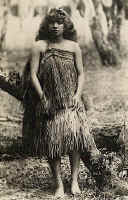
|

|
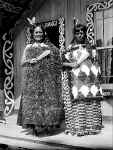
|
|
19
C studio portrait of two Maori girls wearing awarua |
Maori
girl wearing a kakahu
|
Maori
girl wearing a feather kakahu
|
Maori
women at
Whakarewarewa, 1912-26, wearing kakahu
|
haere
come, go
haere mai welcome
haka dance, commonly a war dance
hakari feast
hangi oven comprising a hole in the ground in which food is cooked by heated stones
hapu pregnant; section of tribe; clan; secondary tribe
harakeke flax - a general name covering all varieties
hau wind
hautu give the time (for rowers in a canoe)
Hawaiki legendary homeland of the Maori
hei konei, hei kona goodbye
hei-tiki greenstone ornament worn suspended from the neck
heke migrate; party of emigrants
heke tipi rafter
heru comb for the hair
hiki charm - for raising things from the sea, for causing people to migrate, or for freeing hands
from tapu
hinau Elaeocarpus dentatus - a tree
hoe - paddling (as in a canoe)
homai o homai a gift for a gift
hongi greeting by pressing noses together
hua fruit, egg
huanga relative; member of same hapu
hue calabash gourd
hui assembly
hurukuri dogskin cloak
ika fish
inanga Dracophyllum longifolium - native grass tree
inanga Galaxias attenuatus and Retropinna retropinna - whitebait
iti small
iwi bones; tribe
kahikatea Podocarpus (Dacrycarpus) dacrydioides - white pine
kahikatea Podocarpus excelsum - white pine
kai food; consume; eat
kaik southern variant of kainga
kainga unfortified place of residence; unfortified village
kaitaka cloak of finest flax with ornamental border
kaka Botaurus poeciloptilus - bittern
kaka Nestor meridionalis - native parrot (ka = screech)
kakahi Hydridella menziesi - freshwater bivalve mollusc
kakahu - cloak
kakapo Strigops habroptilus - ground parrot
kamahi Weinmannia racemosa - lowland forest tree
kanakana Geotria australis - lamprey
karaka Corynocarpus laevigatus - forest tree
characaterised by poisonous berries
karakia charm, spell, incantation
karanga call, summon
kaumatu old men (implying respected elders)
kauri Agathis australis - tree yielding the hardest wood
among native New Zealand trees
kauru edible stem of ti-para (Cordyline)
kawhaki tamahine chase for the bride
kea Nestor notabilis - alpine parrot
kei hea where
kereru Hemiphaga novaeseelandiae - wood pigeon
kiekie Freycinetia banksii - a climbing plant
kingitanga pertaining to the Maori King Movement
kino bad
kiore Rattus exulans - native rat thought to have
arrived in New Zealand with the Maori, and used as food
kiwi Apteryx of various species - iconic wingless bird
ko wooden foot hoe for digging or loosening soil prior to planting
koaro Galaxias huttoni - freshwater fish
kohekohe Dysoxylum spectabile - native tree
kohoperoa Eudynamis taitensis - long-tailed cuckoo
kohuru deal treacherously
kokako Callaeas cinerea wilsoni - North Island blue-wattled crow
kokowai red ochre
konini fruit of Fuchsia excorticata
korere
feeding funnel
korero tell; say; discussion
korowai cloak ornamented with black twisted thrums
koruru gable figure
kotuku Egretta alba modesta - white heron
kotukutuku Fuchsia excorticata - a native fuchsia
koura Jasus lalandii, J. hugeli and Paranephrops planifrons - crayfish
kowhai Sophora tetraptera and S. microphylla - native tree species
kumara Ipomoea batatas - sweet potato
kuri dog
kuriawarua dogskin cape
ma (short for manga) tributary or stream
ma white or clear
maeroero fabulous monster
maihi facing boards on gable of house
maire Nestegis spp. - native tree species
mako Isurus oxyrinchus - mako shark
makomako Anthornis melanura - bellbird
makutu bewitch; spell; incantation
mana authority, prestige, influence; psychic force
manaia grotesque beaked figure
manga tributary or stream
manga Thyrsites atun - barracuda
mangeao Litsea calicaris - native tree
mangopare Sphyrna zygaena - hammerhead shark
manu bird
manuka Leptospermum scoparium and L. ericoides - shrub, so-called 'tea tree' as
Capt. Cook used its leaves for brewing tea to combat scurvy
maori normal; usual; ordinary (hence: person of Polynesian race, i.e. not a foreigner)
maoritanga explanation; meaning (hence: lore and customs of the Maori)
marae flat area of ground in front of a meeting house -
the village square or piazza, place of weighty discussion and
consultation - Heimat, one's true home
marakihau fabulous sea monster with tubular tongue
marama moon
mata headland (also many other meanings)
matai Podocarpus spicatus - black pine
maunga mountain
mere short flat stone club for hand-to-hand fighting
miro Podocarpus ferrugineus - brown pine
moa Dinornis gigantea and other species - very large,
flightless bird of order Dinornithiformes, now extinct
moana sea, lake
mokihi raft (made of bundles of rushes or flax)
moko tattooing (on the face or body)
morehu survivors
motu anything isolated, e.g. island
muri end
mutu ended, finished
ngiru-ngiru Petroica toitoi and P. macrocephala macrocephala - white or yellow-breasted tomtit
nguru
nose flute
ngutukaka pattern or ornamental painting for internal house decoration; also the name of an epiphytic
plant
niho tooth
nikau Rhopalostylis sapida - New Zealand palm
niu literally a small stick used for purposes of divination, but
also used to refer to a tall pole erected by Hauhau for ceremonial purposes
noa free from tapu or any other restriction
nui large, great; big, or plenty of
o of; belonging to; the place of
one mud, sand or beach
pa stockade, fortified place
pae ridge, or resting place
pahu gong of stone or wood
pai good, excellent
pakeha foreign; imported (hence: a white person, Englishman)
pakihi barren land
pakipaki dried human head
paoa downward stroke
papa earth; broad, flat, or ground covered with vegetation
paraerae sandal of leaves or flax twisted into a pad
paraheke Gastrodia cunninghamii or Orthoceras strictum - species of large orchid
pare carved slab over door
pataka storehouse raised upon posts
patu strike; beat; club, weapon
patu paraoa whalebone club
patu pounamu greenstone club

wooden
patu |

patu paraoa |

patu paraoa |

patu pounamu |
patupaiarehe sprite; fairy (malign or beneficent)
paua Haliotis of several species - univalve molluscs
peruperu dance
pipi Paphies australis - common edible bivalve
po night
pohutukawa Metrosideros excelsa - red-flowered native tree
poi ball, lump - e.g., light raupo ball with string attached twirled to the accompaniment of a
song
poitoito skirting board at base of walls of house
ponga Cyathea spp. - tree fern
pou-koukou-aro post directly under front gable of house
pou-tahuhu second from front post supporting ridgepole of house
pou-tokomanawa third post supporting ridgepole from front of house
pounamu greenstone, jade
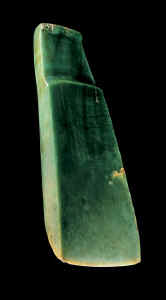
Greenstone adze
blade (toki) |
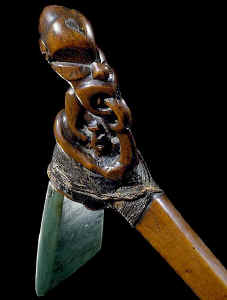
Toki
poutangata (ceremonial_adze) |
poupou upright slab forming solid framework of walls of house
poutahu post supporting end of ridge-pole of a house
poutama stepped pattern on tukutuku ornament of walls of house or mat
powhiri formal welcome
pukatea Laurelia novaezelandiae - native tree
puke hill
pukeko Porphyrio porphyrio - swamp hen
puna spring of water
purapura-whetu pattern of carving or ornamental lattice-work - 'stars in heaven'
puriri Vitex lucens - native tree
rahui a mark to warn against trespassing
rama torch or other artificial light
rangi sky
rangiora Brachyglottis repanda - native shrub
raparapa projecting portion of maihi on house
rata Metrosideros robusta and M. umbellata - species of forest tree
rau hundred, many or leaf
raupo Typha augustifolia - bulrush
rewarewa Knightia excelsa - native forest tree
riki small or few
rimu Dacrydium cupressinum - red pine
riroriro Pseudogerygone igata - grey warbler
roa long, tall, high
roto lake
rua pit for storing food; hole; cave, hollow or two
ruru Ninox novaeseelandiae - owl or morepork
taha
- calabash used for food storage
tahi one, single
tai sea, coast or tide
taiaha weapon of hard wood about 1.6 metres long with one end carved and decorated, the other a
flat smooth blade
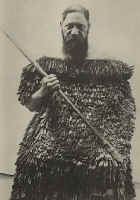
Maori holding a
taiaha
takahe Notornis hochstetteri - large and rare flightless bird
takahe Notornis mantelli - a large and rare flightless bird closely related to the pukeko
takarangi spiral design
tanekaha Phyllocladus trichomanoides - celery pine
tangata man, human being
tangata whenua people of the land, Maori
tangi lamentation; mourning (hence: funeral)
tangiwai transparent variety of greenstone, jade
taniwha fabulous water monster
tapu forbidden or sacred; under strict religious or superstitious restrictions
tara punga Larus novaehollandiae - red-billed gull
taro plant of the arum family cultivated for food
taua hostile expedition; army; war party
tawa Beilschmiedia tawa - native tree
te the (definite article)
tea white or clear
tekoteko carved gable figure
tewhatewha axe-like weapon carved from a single piece of wood or bone
ti Cordyline spp. - cabbage tree
tika just; fair; correct
tiki greenstone figure worn on string around the neck
tipua demon; object of terror
titi-pounamu Ancathisitta chloris - rifleman (a bird)
titoki Alectryon excelsum - a tree
tiwakawaka Rhipidura fuliginosa and R. flabellifera - fantail
(a bird)
toatoa Phyllocladus trichomanoides and P. glaucus - native trees
toetoe grass, sedge, etc. of various species
toheroa Paphies ventricosa - edible bivalve mollusc
tohunga skilled person, wizard, priest
toki adze
totara Podocarpus totara - native forest tree
towai Paratrophis banksii - native tree
tuahu (or tuaahu) a sacred place consisting of an enclosure containing a mound used for mystic rites
tuatara Sphenodon punctatus - a reptile resembling a large lizard
tuatua Paphies subtriangulata - a bivalve mollusc similar to the toheroa
tui Prosthemadera novaeseelandiae - parson bird
tukutuku ornamental lattice-work between upright slabs of the walls of a house
tutae-koka discoloured flaw in greenstone
tutu Coriaria arborea - a shrub
uhi chisel for puncturing skin in tattooing
uku white clay used as soap
umu earth oven
uru-uruwhenua perform rites whereby an object is placed on a wahi tapu (sacred place) with appropriate
karakia
utu revenge, retribution, return (for anything), satisfaction, ransom, compensation; reward, price, make response
wa time, period
wahine woman
wai water
waiata song
waiata aroha love song
waiata tangi song of sorrow
wairua spirit
waka canoe
weka Gallirallus australis and G. hectori - woodhen
wero challenge by throwing a spear
weta Pachyrhamna acanthocera - an insect, a cave weta
whakahe ploy of deliberately putting another person in the wrong
whakapapa genealogical table
whanau family (note: it is questionable whether the Maori had any real concept of the family as a
nuclear unit)
whanga bay, inlet, stretch of water
whare house, habitation; hut, shed
whare runanga meeting house

whare runanga
- photographed before 1906
whare wananga house for instruction in occult lore
whata raised platform for storing food
wheke squid; octopus
wheku distorted figure in carving
whenua land, country
whetu star
|












